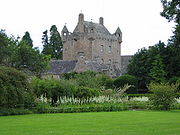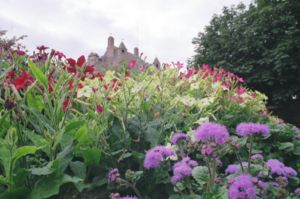
Cawdor Castle
Encyclopedia

Tower house
A tower house is a particular type of stone structure, built for defensive purposes as well as habitation.-History:Tower houses began to appear in the Middle Ages, especially in mountain or limited access areas, in order to command and defend strategic points with reduced forces...
set amid gardens in the parish of Cawdor
Cawdor
Cawdor is a village and parish in Nairnshire, Highland council area, Scotland. The village is situated 5 miles south south west of Nairn, and 12 miles from Inverness.-History:The village is the location of Cawdor Castle, the seat of the Earl Cawdor....
, approximately 10 miles (16 km) east of Inverness
Inverness
Inverness is a city in the Scottish Highlands. It is the administrative centre for the Highland council area, and is regarded as the capital of the Highlands of Scotland...
and 5 miles (8 km) southwest of Nairn
Nairn
Nairn is a town and former burgh in the Highland council area of Scotland. It is an ancient fishing port and market town around east of Inverness...
in Scotland
Scotland
Scotland is a country that is part of the United Kingdom. Occupying the northern third of the island of Great Britain, it shares a border with England to the south and is bounded by the North Sea to the east, the Atlantic Ocean to the north and west, and the North Channel and Irish Sea to the...
, United Kingdom. It belonged to the Clan Calder
Clan Calder
Clan Calder is a Highland Scottish clan. The clan does not currently have a chief therefore it is considered an Armigerous clan.-Origins of the Clan:...
. It still serves as home to the Dowager
Dowager
A dowager is a widow who holds a title or property, or dower, derived from her deceased husband. As an adjective, "Dowager" usually appears in association with monarchical and aristocratic titles....
Countess Cawdor, stepmother of Colin Robert Vaughan Campbell, 7th (and present) Earl Cawdor and 25th Thane of Cawdor
Colin Campbell, 7th Earl Cawdor
Colin Robert Vaughan Campbell, 7th Earl Cawdor , is a Scottish earl in the Peerage of the United Kingdom and an architect by profession. He is also known for having legal issues with his stepmother Countess Cawdor. He is the elder son and third child of Hugh John Vaughan Campbell, 6th Earl Cawdor...
. The castle is perhaps best known for its literary connection to William Shakespeare
William Shakespeare
William Shakespeare was an English poet and playwright, widely regarded as the greatest writer in the English language and the world's pre-eminent dramatist. He is often called England's national poet and the "Bard of Avon"...
's tragedy Macbeth
Macbeth
The Tragedy of Macbeth is a play by William Shakespeare about a regicide and its aftermath. It is Shakespeare's shortest tragedy and is believed to have been written sometime between 1603 and 1607...
, the title character of which was made Thane of Cawdor. However, the story is highly fictionalised, and the castle itself was built many years after the events of the play.
History
The earliest documented date for the castle is 1454, the date a building license was granted to William, Thane of Cawdor (or Calder, as the name was sometimes spelled). However, some portions of the castle may precede that date. Architectural historians have dated the style of stonework in the oldest portion of the castle to approximately 1380.
Originally consisting only of the large tower (or keep
Keep
A keep is a type of fortified tower built within castles during the Middle Ages by European nobility. Scholars have debated the scope of the word keep, but usually consider it to refer to large towers in castles that were fortified residences, used as a refuge of last resort should the rest of the...
), the castle was expanded numerous times in the succeeding centuries, with significant additions made in the 17th century and 19th century. The iron yett
Yett
A yett is a gate or grille of latticed wrought iron bars used for defensive purposes in castles and tower houses...
here was brought from nearby Lochindorb Castle around 1455 when the Scottish Privy Council instructed the Thane of Cawdor to dismantle Lochindorb after it had been forfeited by the Earl of Moray
Archibald Douglas, Earl of Moray
Archibald Douglas, Earl of Moray was a Scottish nobleman during the reign of King James II of Scotland. He was one of the five brothers from the Black Douglas family who clashed with the king....
.
Gardens

Lichen
Lichens are composite organisms consisting of a symbiotic organism composed of a fungus with a photosynthetic partner , usually either a green alga or cyanobacterium...
).
Shakespeare connection
Shakespeare's play Macbeth took liberties with the story of the historic Scottish King MacbethMacbeth of Scotland
Mac Bethad mac Findlaích was King of the Scots from 1040 until his death...
, who ruled Scotland after his forces killed King Duncan of Scotland
Duncan I of Scotland
Donnchad mac Crínáin was king of Scotland from 1034 to 1040...
in battle (not assassination, as in the play). The play, first written in 1606, drew from somewhat fanciful tales of King Macbeth written by the monk Andrew of Wyntoun
Andrew of Wyntoun
Andrew Wyntoun, known as Andrew of Wyntoun was a Scottish poet, a canon and prior of Loch Leven on St Serf's Inch and later, a canon of St...
(in Fife
Fife
Fife is a council area and former county of Scotland. It is situated between the Firth of Tay and the Firth of Forth, with inland boundaries to Perth and Kinross and Clackmannanshire...
) in his Cronykil (completed in 1406). Among the elements Shakespeare took from the monk's stories was the idea of the three prophesying weird sisters.
In the play, Shakespeare has the three sisters foretell that Macbeth, then Thane of Glamis
Glamis
Glamis is a small village in Angus, Scotland, located four miles south of Kirriemuir and five miles southwest of Forfar. It is the location of Glamis Castle, the childhood home of Queen Elizabeth the Queen Mother.-History:...
, would become Thane of Cawdor and King thereafer. Duncan, indeed, almost immediately thereafter makes Macbeth Thane of Cawdor. Believing it necessary to accomplish the remainder of the prophecy, Macbeth and his Lady murder Duncan in his sleep, an act that leads to Macbeth's ultimate downfall.
In the play, the murder of Duncan takes place in Macbeth's castle in Inverness, not Castle Cawdor (hardly surprising, as Macbeth had only just been granted the title Thane of Cawdor and thus would not yet have made any castle in Cawdor his home).
Although the name Cawdor will forever connect this classic work of literature to Cawdor Castle, the castle did not exist during the lifetimes of Macbeth or Duncan, and the events of the play are almost wholly fictitious. The castle's guidebook quotes the 5th Earl Cawdor (the 23rd Thane) as saying, presumably with some irony, "I wish the Bard had never written his damned play!"

